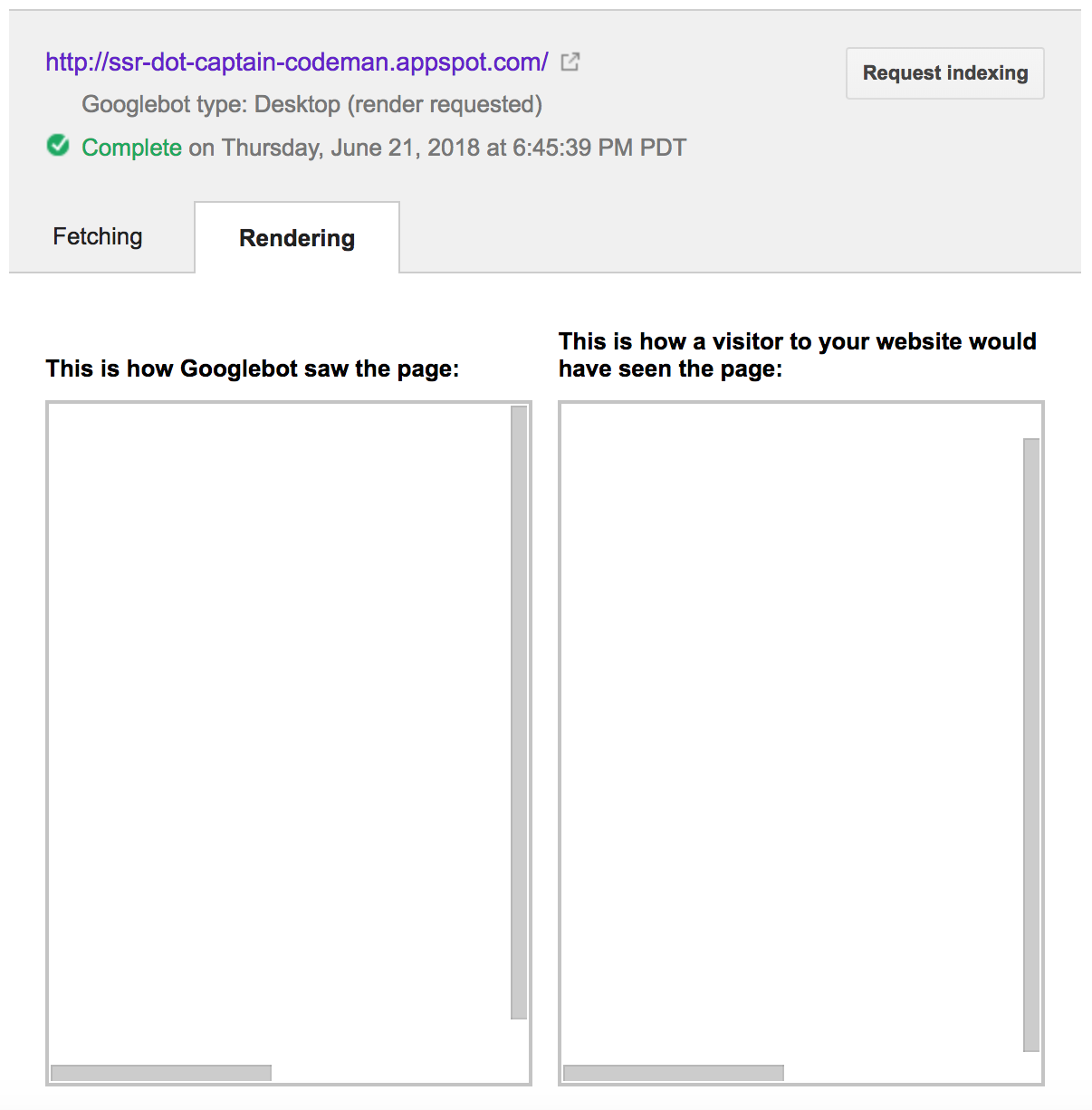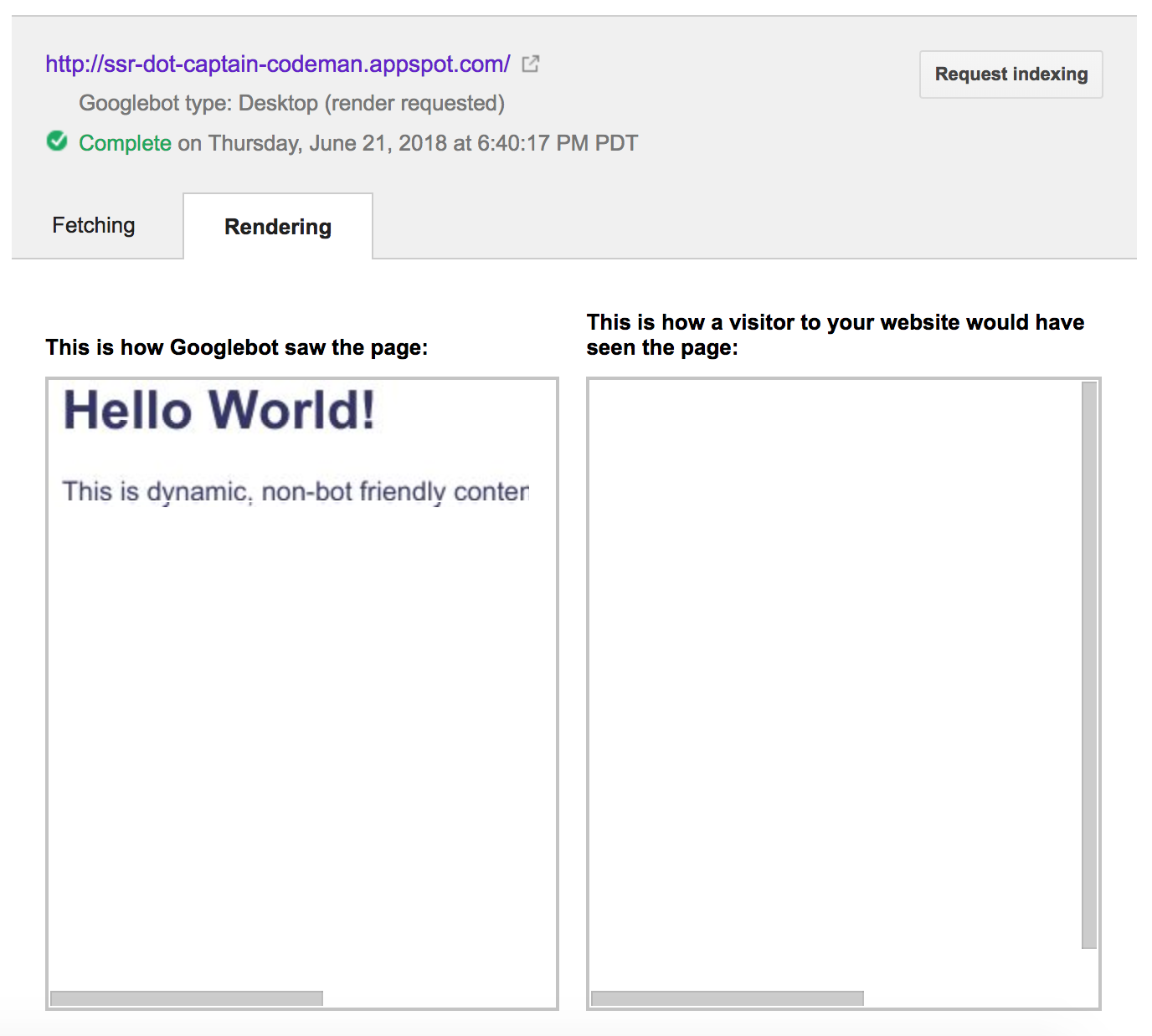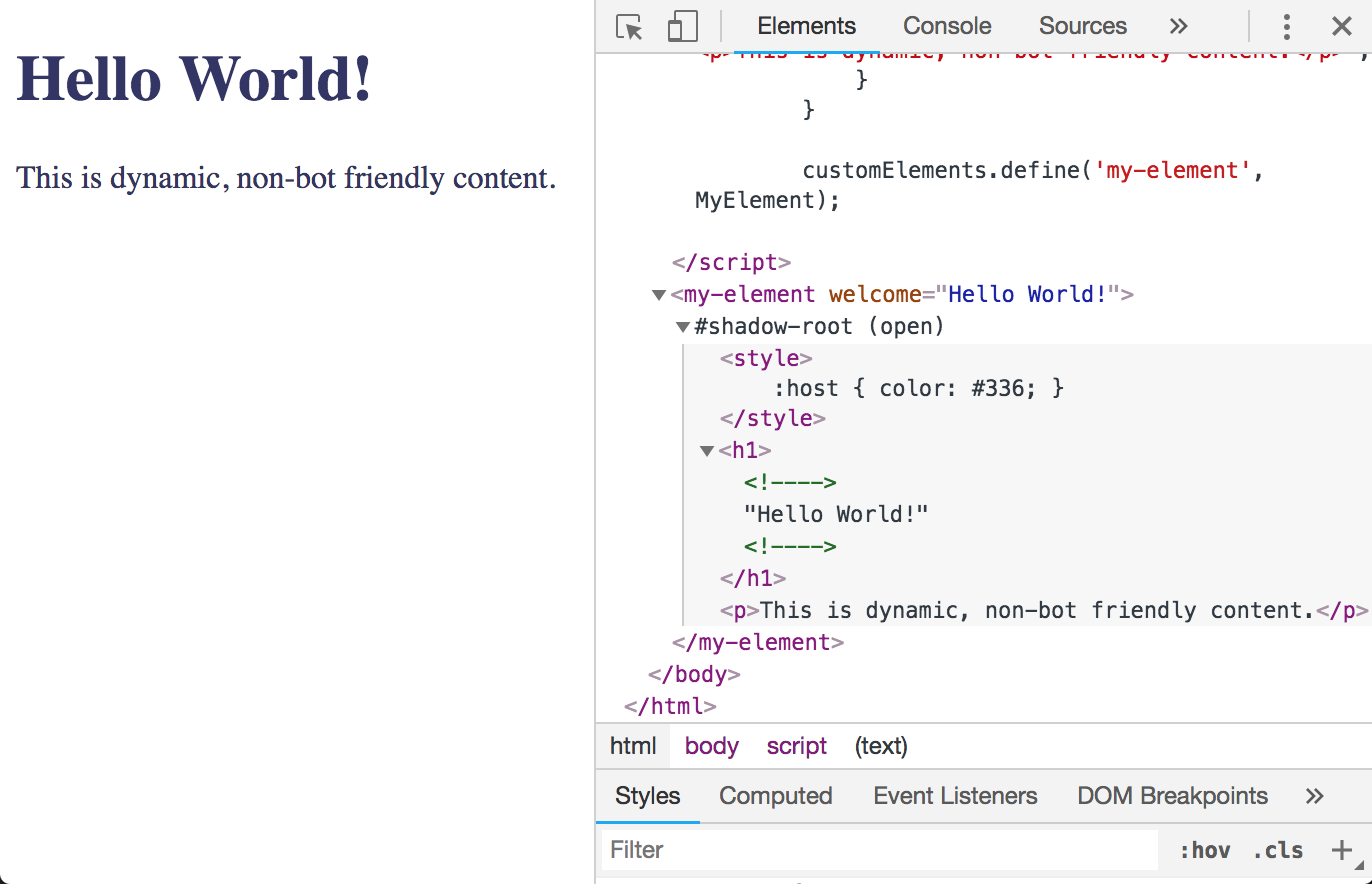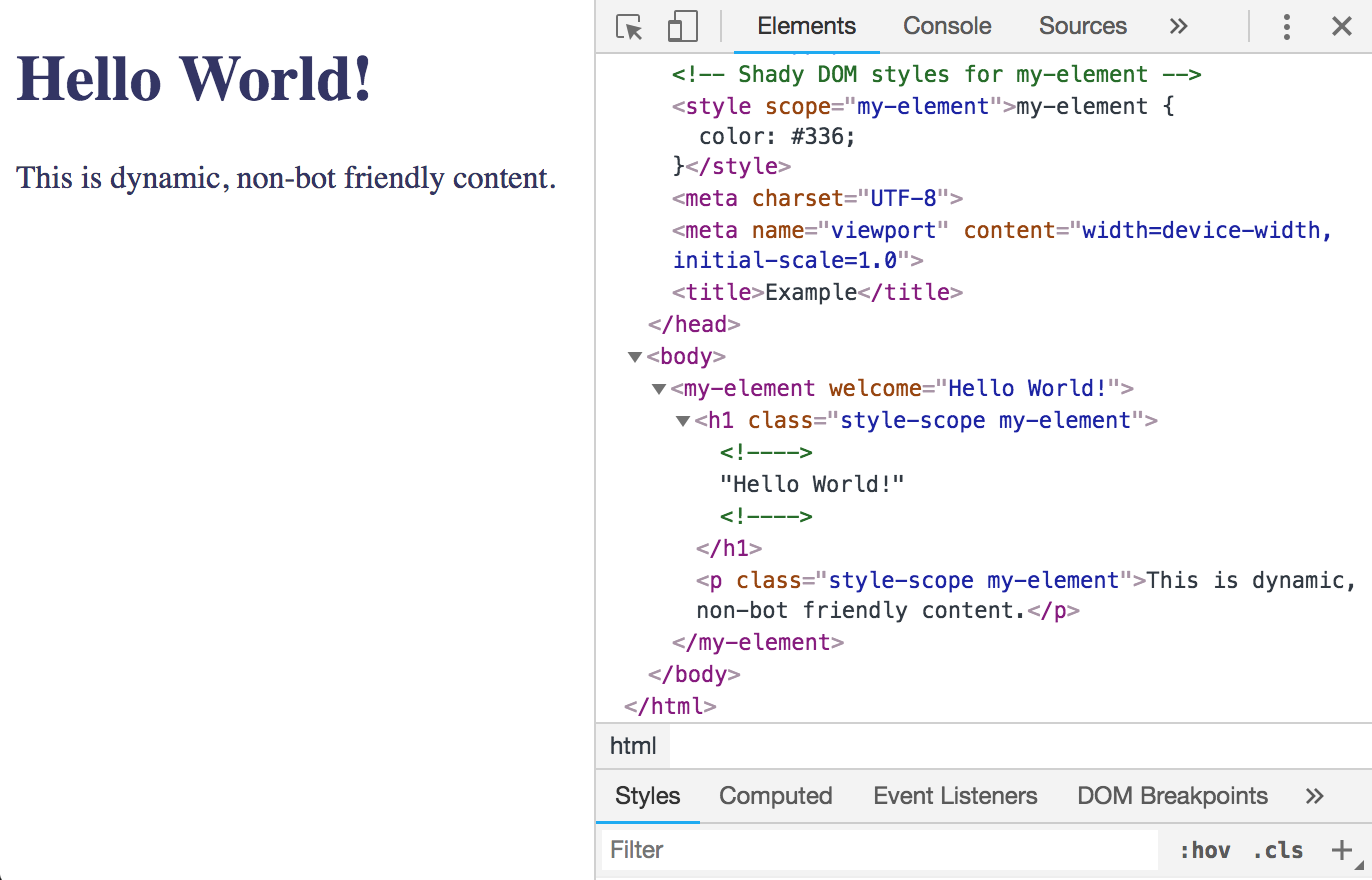Http middleware for AppEngine to selectively Server-Side Render a page and optionally caching the results. Designed to work with Puppeteer.
Say you have the latest and greatest front-end web-client technology for your new site. All your users have one of the latest evergreen browsers that support the new platform features you make use of so everything is good ...right?
Unfortunately, Googlebot is based on a much older version of Chrome that doesn't support these new features so it probably doesn't understand any of it. Oh dear. ShadowDOM? WebComponents? ES6? What are they?
Here's how your sweet UI appears to Googlebot (using the
"Fetch as Google" feature in Webmaster Tools):

Yeah, your SEO isn't even SE happy, let alone Optimized ...
Not only is it bad for Search Engine traffic but any web requests that expect to see meta-data in the page source will be disappointed which means rich embedding of content cards within sites such as Facebook and Twitter won't work either. There are more users of your site than humans with web-browsers.
One solution is to use Server-Side Rendering and there have been a number of services that offer this but they can be expensive especially if you have a large site with lots of changing content. Some client frameworks also provide options for Server-Side Rendering but they add complexity if they work at all.
Fortunately, there's now the option of using a "headless" Chrome browser via Puppeteer which is what this middleware is intended to help with. It means when the Googlebot (or any other bot you configure) requests your site it can be converted into ye-olde HTML like a static site. Now your site can be rendered and understood. SEO glory awaits!
The middlware checks if the request is coming from any of the configured bots by parsing the User-Agent string of the request. If it isn't, it's processed as normal and the package does nothing.
If it is a bot request, the middleware first checks if the
URL has already been server-side rendered and cached (because
it can be a bit expensive to do you don't want to do it every
time) and will serve that instead. The caching is configurable
and can be turned off. If there is no cached version then the
middleware calls the Puppeteer service to render the page but
adds an extra headless QueryString parameter to the URL when
doing so.
The page should use this headless parameter to configure
rendering using ShadyDOM (otherwise the Chrome version used
by Puppeteer will render the exact same version the app would
have sent for the request anyway). Enabling ShadyDOM means the
content will be rendered as a regular DOM tree and any dynamic
content that relies on JavaScript to render will be included
with the JavaScript then removed. The result is pure HTML &
CSS content which can be understood by any bot or other client.
The middleware checks requests for the headless parameter
so it can prevent any 'render-loop' and you can also pass in
another configurable QueryString option (the default is ssr)
to force Server Side Rendering which is useful while testing.
A typical client-side rendered page is available at: http://ssr-dot-captain-codeman.appspot.com/
Here's how the DOM looks when rendered in a modern browser such as Chrome. Note the shadow-root:
To view the page as it would look when Server-Side Rendered
you can override the User-Agent parsing by adding ?ssr to
the URL:
http://ssr-dot-captain-codeman.appspot.com/?ssr
Now the content is rendered as a regular DOM tree which can be understood by any bot. If you generate metadata in your front-end framework, this will enable services such as Facebook and Twitter to render it:
Install using go get
go get -i github.com/captaincodeman/appengine-ssr
Create an instance of the SSR middleware and add it to your Router package of choice (or wrap the standard http package Mux). It uses another Appengine Context Middleware Package so needs to be added high in the middleware chain before any other changes the request. If you use that package to access AppEngine Services you don't need to add the middleware for it. Having the middleware early in the request lifecyle makes sense because the request isn't going to be handled directly anyway.
Example:
package main
import (
"time"
"net/http"
"google.golang.org/appengine"
"github.com/captaincodeman/appengine-ssr"
)
func main() {
mw := ssr.NewSSR("https://pptraas.com")
handler := http.HandlerFunc(handle)
http.Handle("/", mw.Middleware(handler))
appengine.Main()
}
func handle(w http.ResponseWriter, r *http.Request) {
http.ServeFile(w, r, "index.html")
}The only mandatory configuration setting is the address of the Puppeteer rendering service. The example above uses the Puppeteer as a Service example but you should really run your own instance to guarantee performance - I'll add an example for creating one using Google Compute Engine Docker Optimized instances which can auto-scale and ensure availability.
Other configuration options can be added to the constructor for example, if you want a shorter cache expiration and have logging enabled:
mw := ssr.NewSSR("https://pptraas.com",
ssr.Expiration(time.Minute*10),
ssr.Verbose(true),
)Options available:
ssr.UserAgents(userAgents []string)
Set the User-Agents that will be Server Side Rendered. The default list is:
var defaultUserAgents = []string{
"W3C_Validator",
"baiduspider",
"bingbot",
"facebookexternalhit",
"LinkedInBot",
"Pinterest",
"Slackbot-LinkExpanding",
"TwitterBot",
"Googlebot",
"Mediapartners-Google",
}ssr.UserAgentParser(parser *uaparser.Parser)
Set the User-Agent Parser to use if, for instance, you didn't want to use the built-in User-Agent string definitions.
ssr.Verbose(verbose bool)
Set to true to output additional information to the AppEngine logs (Stackdriver).
ssr.Timeout(timeout time.Duration)
Timeout for request to Puppeteer service (default 30 seconds).
ssr.NoCache()
Disables caching of Server-Side Rendered content.
ssr.Memcache(prefix string)
Cache Server-Side Rendered content using the built-in AppEngine Memcache service (default). A prefix string will be added to the cache key to avoid collisions with any other caching your app may be performing.
ssr.Expiration(expiration time.Duration)
Set the cache expiration (default 1 hour). This will save repeat bot-requests within that time from being re-rendered (as long as the items aren't evicted from the cache).
ssr.HeadlessParam(name string)
Set the name of the querystring parameter used to indicate
a 'headless' request (default headless).
ssr.OverrideParam(name string)
Set the name of the querystring parameter used to override
SSR rendering (default ssr). Set to empty to disable the
option.
This could probably be made more generic by having all the AppEngine specific pieces be separate configurable services as the Memcache option already is and other pieces set to be conditionally compuled. But my current requirements only need it to work with AppEngine so that's what it does ... for now.


